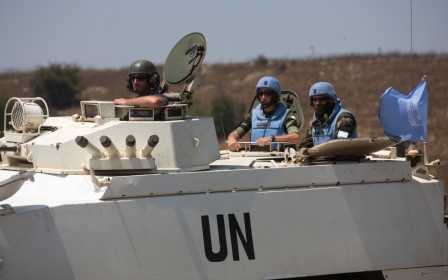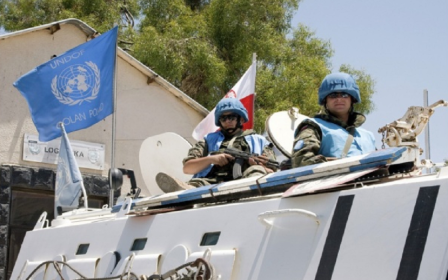Residents in occupied Golan Heights fear creeping Israeli presence

MAJDAL SHAMS - Home-shaking booms and the ripple of not-so-distant shelling have become part of the daily soundtrack for Syrians living in the Israeli-occupied Golan Heights. While the uprising that broke out peacefully in March 2011 devolved into gruesome violence and sectarian strife, locals have watched cautiously from across the Israeli-built barrier separating the occupied territory from the rest of their homeland.
As the conflict creeps closer to the area, Israel’s military has increased its presence. Many more tanks, army jeeps and military outposts are scattered across the rolling green hills than ever before.
Aamer Ibrahim, 24, searched for the words to describe the difficult situation Syrians in the occupied Golan have found themselves in.
“It’s hard for me to hide my concern over the situation in Syria,” the Majdal Shams-based activist told Middle East Eye. “It’s not just about it being closer to us than it was before. I think from the early days [of the conflict] people in the Golan felt that the events would affect them directly. They turned out to be right.”
Israel occupied the Golan Heights during the 1967 Middle East war and expelled most of its indigenous Syrian residents. Today, only an estimated 20,000 Syrians – most of them from the Druze religious minority – live in the six villages left standing. Wrapping around mountainous terrain, crowded communities testify to underdevelopment and economic neglect. Severed from the broader Syrian population, these villages lack resources and depend primarily on agricultural income.
Yet the Golan is also home to some 21,000 Israeli settlers. Protected by the military, 33 Jewish-only colonies, each of them surrounded by high fencing and accessible through checkpoints, resemble verdant southern California suburbs and bear the markings of heavy state-subsidisation.
Though Israel has claimed to annex the territory, the international community considers it illegally occupied and the overwhelming majority of its indigenous Syrian residents have rejected offers of Israeli citizenship.
“The situation has already spilled over into the Golan,” Ibrahim added, sitting on his patio as a staccato of shelling rang out from the nearby barrier separating the Israeli-controlled side and the roughly 30 percent of the Golan still under Syrian control. "It doesn't just shape the local social and political dynamics -- for example, our being divided towards the al-Assad government -- but it also reshapes the international focus on the region in general and the Golan specifically."
“To be honest, I’m worried about every single Syrian citizen, including us,” Ibrahim continued. “There is not a single Syrian living in peace, not inside Syria or out of it.”
The last two years have seen a massive influx of fighters, many of them foreign, into the country adding to the horsepower of militant Islamist groups like the Islamic State and Jabhat al-Nusra.
After they overwhelmed pro-Assad forces late last Wednesday, rebel forces, including members of the al-Qaeda linked Jabhat al-Nusra, took control of the Quneitra crossing between the Israeli-occupied Golan Heights and the rest of Syria. Quneitra, the only crossing between the Israeli- and Syrian-controlled sides, is residence to UN peacekeeping forces and provides passage for students and religious travelers.
At least 44 peacekeeping soldiers were taken captive by the rebels. The UN was reportedly informed by the rebels that the purpose of capturing the peacekeepers was “to remove them from an active battlefield to a safe area for their own protection,” AFP reported Saturday. Negotiations are reportedly underway to secure their release.
Jabhat al-Nusra also released a video of its forces fighting during the battle to control Quneitra. “We are al-Nusra fighters,” one of the men says in the video. “We have liberated the Syrian-Zionist crossing of Quneitra.”
Israel has yet to officially respond to the capture of the Quneitra crossing. “I can tell you that we are keeping our eyes open,” an Israeli military spokesperson told Middle East Eye, declining to further comment.
Many worry about the fates of their relatives in Syria as the death toll continues to climb. According to the United Nations’ most recent statistics, more than 191,000 people have died throughout the course of the war.
“There is a lot of fear among the people here, especially now that extremists are on the border. I have relatives in Syria today living this sectarian nightmare,” Randa, a resident of Majdal Shams who studied in Damascus for several years. “Like the other people here with relatives, I worry about them. I am against sectarianism and stand with Syrians wherever they are and whoever they are.”
Her husband Yasser, a 37-year-old poet also originally from Majdal Shams, summed up the violence in Syria as a game of interests. “In my opinion, what’s happening in Syria is a struggle between a criminal side, the regime, and extremists like the Islamist state and Jabhat al-Nusra,” he said, adding that he maintains his support for revolution against the Assad government.
“The biggest problem is that the media is indirectly supporting the extremists by giving them all the coverage. The Syrian civilian isn’t benefitting from a single thing that is happening today,” Yasser said.
“Israel is benefiting from the crisis in Syria more than anyone else,” he added. “True freedom for Syrians means both ending al-Assad’s oppression and the illegal Israeli occupation.”
Even as the scenes of horror continue to unfold, Golan natives say there is an unshakable consensus against Israel. Some accuse Israel of increasing its efforts to colonise the region and strengthen its institutions of occupation.
Among those efforts was a hushed plan by an Israeli nonprofit organisation to recruit Syrians into civil service for the Israeli government. As soon as locals caught wind of the program’s aims, those who had registered dropped out.
Israeli authorities announced last month that they intend to invest more than $5,000,000 in the Katzrin settlement in the Golan. Among other projects, the money would be invested in promoting tourism and increasing the number of students at a local academic college.
In January 2014, the Israeli government also declared its intent to confiscate some 7,400 acres of land for agricultural use, including the “establishment of 750 farming estates with a $108-million investment from the Israeli government,” according to Al-Marsad human rights group.
Back on the porch of his hillside home in Majdal Shams, activist Aamer Ibrahim looks out at the barrier that enveloped the Golan long before it kept out Jabhat al-Nusra and the Islamic State. “The ongoing battle in Quneitra and the crossing is moving the focus of the war from Syria’s interior to its borders. I’m unable to hide my concern regarding the situation in these occupied territories also,” he said.
“I’m not just worried because of the barbaric acts and beliefs of the extremist groups fighting in this war or because they may eventually arrive in the Golan on our land. I’m also worried because I don’t trust Israel’s motives for ‘protecting’ us,” Ibrahim continued.
“It is still an illegal occupation building colonies on Syrian land,” he concluded.
Middle East Eye propose une couverture et une analyse indépendantes et incomparables du Moyen-Orient, de l’Afrique du Nord et d’autres régions du monde. Pour en savoir plus sur la reprise de ce contenu et les frais qui s’appliquent, veuillez remplir ce formulaire [en anglais]. Pour en savoir plus sur MEE, cliquez ici [en anglais].




